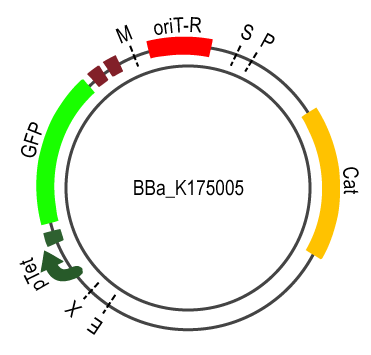Team:TUDelft/Conjugation Overview
From 2009.igem.org
Module 1: Conjugation system
The goal of the Conjugation module was to create a 'helper' plasmid which could conjugate a signal plasmid to other cells containing the helper plasmid. While this type of system has been hinted at in the past, it has never been implemented due to several reasons. Conjugative plasmids contain membrane bound protein known as 'entry exclusion' or 'surface exclusion' protein [5] which prevent conjugation between two cells containing the same plasmid. Creating a system which can achieve our goal requires several knockouts to be done on the conjugative plasmid.
Selecting the Conjugation system
There are many different conjugation systems, with F and IncP being among the most used by previous iGEM teams. The IncP incompatibility group is further divided into two groups IncP-alpha aka Birmingham aka RP4 plasmid and the IncP-beta R751 plasmid. We chose to use the IncP-beta system R751 plasmid for several reasons:
- F has two surface exclusion proteins (TraT, TraS), while IncP has only one (trbK) [4]
- F has a self-imposed fertility inhibition system (new donors fertile for only about 6 generations), while IncP systems have no self-imposed fertility inhibition system. [4]
- Smaller plasmid size:
- The R751 oriTR has been [http://partsregistry.org/wiki/index.php?title=Part:BBa_I714031 biobricked] and verified to be working.
Our helper plasmid is be based on a modified R751 plasmid.
Selecting genes to knockout
Entry exclusion
As mentioned earlier, the goal of this part of the project is to allow a signal plasmid to be transmitted between cells containing conjugation helper plasmids (modified R751). In nature this does occur but at very low levels, due to the presence of entry exclusion proteins [5]. These membrane-bound proteins block incoming transfers from cells containing the conjugative plasmid. Note that in order for the transfer to be blocked their presence is required only in the recipient. These entry exclusion proteins are present for two primary reasons:
- to prevent redundant transfer of the conjugative plasmid among a population of cells
- to prevent lethal zygosis [6].
In R751 the gene trbK encodes for the entry exclusion protein [7. Its presence is not required for conjugation to occur [8]. Some papers have reported that knocking out the trbK genes in other plasmids did not affect the conjugation frequency: "transfer of the trbK mutant occurred at near-wild-type frequencies"[9]. Given this information, we proposed to knockout the trbK gene from R751. In the fully integrated signal plasmid, the expression of trbK would prevent the signal from propagating backwards. With this in mind it was decided to also synthesize and characterize the trbK gene.
Preventing the Transfer of the Helper Plasmid
In our system, we would like only the small signal plasmid to be conjugated not the large helper plasmid. Methods to acheive this have previously been demonstrated at iGEM by teams including [http://parts2.mit.edu/wiki/index.php/Berkeley2006-ConjugationMain Berkeley '06] and [http://parts.mit.edu/igem07/index.php/Peking_Hop-Count Peking '07]. By removing the origin of transfer region from R751 and placing it on the signal plasmid, the signal plasmid will be transmitted during the conjugation while R751 ΔoriTR will not. Since no R751 ΔoriTR plasmid was available in the registry we added the oriTR region to the list of knockouts needed.
Lethal Zygosis
What is lethal zygosis? Essentially this is a problem caused when cells attempt to conjugate too much leading to damage in their membrane.
"We find that diaminopimelic acid in the recipient membrane is released into the medium during bacterial matings, indicating that membrane damage was inflicted on the recipient by the donor, probably for forming a channel for DNA transfer. When the damage is extensive, as in matings with an excess of Hfr bacteria, the F- bacteria are killed (lethal zygosis). The transfer of a large amount of DNA in Hfr matings appears to enhance the killing." [6]
By knocking out the trbK gene we may be exposing our cells to lethal zygosis. If this is indeed the case than knocking out one of the critical mating pair formation genes (trbB, trbC, trbD, trbE, trbF, trbG, trbH, trbI, trbJ, trbL) from the trb operon would prevent this. The gene would be placed on the signal plasmid so that once a cell contining the helper plasmid has also received the signal plasmid, it will have all of the genes necessary to conjugate the signal plasmid further. We selected the gene trbC due to its small size and position on the operon. trbC is known to encode for the pilin subunits needed for pilus formation. So without this gene present the cells will not conjugate and will thus not be succeptible to lethal zygosis. We proposed to do the trbC knockout as out final knockout if lethal zygosis was shown to be an issue.
Conjugation Testing Plasmids
Conjugation Testing Plasmid 1 K175005
The first testing plasmid simply consists of constitutively expressed GFP and oriTR. The GFP expression allows simple recognition of transconjugants in a conjugation test on the macroscale, or visualization of the signal propagation on the microscale with an epifluorescence microscope. The oriTR enables the plasmid to be transmitted.
These are the BioBricks needed to assemble [http://partsregistry.org/wiki/index.php?title=Part:BBa_K175005 Conjugation Testing Plasmid 1]:
- [http://partsregistry.org/Part:BBa_I13522 BBa_I13522] (pTet-RBS-GFP-term-term)
- [http://partsregistry.org/wiki/index.php?title=Part:BBa_I714031 BBa_I714031] (oriTR)
Conjugation Testing Plasmid 2 K175006
The second testing plasmid is similar to the first plasmid but also contains the trbK entry exclusion gene. This prevents redundant transfer of the plasmid and reduces lethal zygosis issues.
These are the BioBricks needed to assemble [http://partsregistry.org/wiki/index.php?title=Part:BBa_K175006 Conjugation Testing Plasmid 2]:
- [http://partsregistry.org/wiki/index.php?title=Part:BBa_J13002 BBa_J13002] (pTet-RBS)
- [http://partsregistry.org/wiki/index.php?title=Part:BBa_K175001 BBa_K175001] (trbK)
- [http://partsregistry.org/wiki/index.php?title=Part:BBa_E0840 BBa_E0840] (RBS-GFP-term-term)
- [http://partsregistry.org/wiki/index.php?title=Part:BBa_I714031 BBa_I714031] (oriTR)
 "
"









